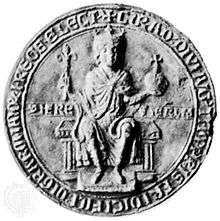Conrad IV of Germany
| Conrad of Swabia | |
|---|---|
 | |
| King of the Romans | |
| Reign | May 1237 – 21 May 1254 |
| Predecessor | Henry (VII) |
| Successor | William |
| King of Sicily | |
| Reign | 13 December 1250 – 21 May 1254 |
| Predecessor | Frederick I |
| Successor | Conrad II |
| King of Jerusalem | |
| Reign | 25 April 1228 – 21 May 1254 |
| Predecessor | Isabella II and Frederick I |
| Successor | Conrad III |
| Duke of Swabia | |
| Reign | 12 February 1235 – 21 May 1254 |
| Predecessor | Henry |
| Successor | Conrad IV |
| Born |
25 April 1228 Andria, Kingdom of Sicily |
| Died |
21 May 1254 (aged 26) Lavello, Basilicata |
| Burial | Messina Cathedral |
| Spouse | Elisabeth of Bavaria |
| Issue | Conradin |
| House | Hohenstaufen |
| Father | Frederick II, Holy Roman Emperor |
| Mother | Isabella II of Jerusalem |
| Religion | Roman Catholicism |
Conrad (25 April 1228 – 21 May 1254) of Hohenstaufen was Duke of Swabia (1235–1246), King of Jerusalem (as Conrad II; 1228–1254), King of Germany (as Conrad IV; 1237–1254), King of Italy and of King of Sicily (as Conrad I; 1250–1254).
Early years
He was the second but only surviving son of Emperor Frederick II and Isabella II (Yolanda), the queen regnant of Jerusalem. Born in Andria, in the South Italian Kingdom of Sicily, his mother died while giving birth to him and he succeeded her as monarch of the Crusader state of Jerusalem. By his father, Conrad was the grandson of the Hohenstaufen emperor Henry VI and great-grandson of Emperor Frederick Barbarossa. He lived in Southern Italy until 1235, when he first visited the Kingdom of Germany. During this period his kingdom of Jerusalem, ruled by his father as regent through proxies, was racked by the civil War of the Lombards until Conrad declared his majority and his father's regency lost its validity.
Rise to power
When Emperor Frederick II deposed his eldest son, Conrad's rebellious half-brother King Henry (VII), Conrad succeeded him as Duke of Swabia in 1235. However, the emperor was not able to have him elected King of the Romans until the 1237 Imperial Diet in Vienna. This title, though not acknowledged by Pope Gregory IX, presumed his future as a Holy Roman Emperor. Prince-Archbishop Siegfried III of Mainz, in his capacitiy as German archchancellor, acted as regent for the minor until 1242, when Frederick chose Landgrave Henry Raspe of Thuringia, and King Wenceslaus I of Bohemia to assume this function. Conrad intervened directly in German politics from around 1240.
However, when Pope Innocent IV imposed a papal ban on Frederick in 1245 and declared Conrad deposed, Henry Raspe supported the pope and was in turn elected as anti-king of Germany on 22 May 1246. Henry Raspe defeated Conrad in the battle of Nidda in August 1246, but died several months later. He was succeeded as anti-king by William of Holland.
Also in 1246, Conrad married Elisabeth of Bavaria, a daughter of Otto II Wittelsbach, Duke of Bavaria. They had a son
- Conradin, in 1252.
In 1250 Conrad settled momentarily the situation in Germany by defeating William of Holland and his Rhenish allies.
Italian Campaign
When Frederick II died in the same year, he passed Sicily and Germany, as well as the title of Jerusalem, to Conrad, but the struggle with the pope continued. Having been defeated by William in 1251, Conrad decided to invade Italy, hoping to regain the rich dominions of his father, and where his brother Manfred acted as vicar. In January 1252 he invaded Apulia with a Venetian fleet and successfully managed to restrain Manfred and to exercise control of the country. In October 1253 his troops conquered Naples.
Conrad was however not able to subdue the pope's supporters, and the pope in turn offered Sicily to Edmund Crouchback, son of Henry III of England (1253). Conrad was excommunicated in 1254 and died of malaria in the same year at Lavello in Basilicata.[1] Manfred first, and later Conrad's son Conradin, continued the struggle with the Papacy, although unsuccessfully.
Conrad's widow Elisabeth remarried to Meinhard II, Count of Tirol, who in 1286 became Duke of Carinthia.
Conrad's death in 1254 began the Interregnum, during which no ruler managed to gain undisputed control of Germany and no one was crowned Emperor. The Interregnum ended in 1273, with the election of Rudolph of Habsburg as King of the Romans.[2]
Ancestors
See also
- Kings of Germany family tree. He was related to every other king of Germany.
References
| Conrad IV of Germany Born: 1228 Died: 1254 | ||
| Regnal titles | ||
|---|---|---|
| Preceded by Isabella II and Frederick |
King of Jerusalem 1228 – 1254 |
Succeeded by Conradin |
| Preceded by Frederick II |
King of Sicily Duke of Swabia 1250 – 1254 | |
| King of Germany and Italy 1237 – 1254 with Frederick II (1237-1250) |
Succeeded by William as anti-king since 1247 | |
.svg.png)
.svg.png)